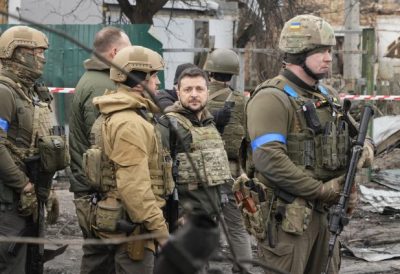Kiev’s High Mobility Artillery Rocket Systems (HIMARS) to Target Russia Controlled Areas

All Global Research articles can be read in 51 languages by activating the “Translate Website” drop down menu on the top banner of our home page (Desktop version).
To receive Global Research’s Daily Newsletter (selected articles), click here.
Follow us on Instagram and Twitter and subscribe to our Telegram Channel. Feel free to repost and share widely Global Research articles.
***
Kiev is now employing the High Mobility Artillery Rocket Systems (HIMARS) provided by Washington to strike Moscow-controlled areas. Such missiles hit warehouses in Nova Kakhovka – in the Kherson region – containing saltpetre, a chemical compound that is used to make gunpowder and fertilizers.
Ukraine claims the target was an ammunition dump. The strike caused a major explosion and fires. Shops, gas stations, pharmacies, a church, and other civilian buildings were also hit. At least seven people were killed and 60 have been wounded, according to Vladimir Leontyev, head of the Russian-controlled Kakhovka District military-civilian administration.
The first M142 HIMARS arrived in Ukraine at the end of June and have been linked to explosions in the Donbass region and southern Ukraine. In its counter-offensive, the Ukrainian authorities are indiscriminately attacking the areas whose control they lost and are basically shelling the very population they consider to be their own people – using American weapons for that. City districts have been leveled, with civilian infrastructure destroyed and many civilians killed in the process.
Last week, Alexandr Shulguin, Moscow’s permanent representative at the Organization for the Prohibition of Chemical Weapons (OPCW), warned that Kiev is preparing provocations with chemical weapons at the Nikolaevka thermal power plant and also at other locations in Kharkiv. He told Rossiya 24 channel that a note was sent to the technical secretariat of the OPCW.
Kiev was in control of the Azot chemical factory in Severodonetsk (now taken by the Russians forces), and, on June 25, Ukrainian shelling forced Russian forces to suspend the evacuation of civilians from the plant. Hundreds of people had taken shelter there. Ukrainian troops also shelled the Yasinovka coking chemical plant in the Kirovsky district of Makiivka in the Donetsk People’s Republic (DPR) on June 19.
Already in May there were reports that Ukrainian nationalist battalions were plotting provocations at the chemical facilities in the so-called “chemical industry triangle” (Severodonetsk, Lisichansk, and Rubezhnoye), which is home to over 30 chemical factories. On May 6, Mikhail Mizintsev, chief of Russia’s National Defense Management Center, had already warned about Kiev’s plans to deploy “heavy weapons” against chemical plants in the region. In fact, the Ukrainian military has been gathering information about chemical facilities in the Donbass, both in the DPR and the Luhansk People’s Republic (LPR).
Thus, the Ukrainian strategy that is unfolding now seems to involve attacking chemical plants and facilities. And US-provided missile systems might be used for that very purpose. The environmental hazards of this are quite obvious, not to mention the humanitarian disaster and the potential long-term health effects on the population even after the end of the conflict for many years to come (due to soil and water contamination). A lot of chemicals are stored in Donbass, which is a heavily industrialized region. It is also home to a number of mines which are currently closed. If a dam is broken, mercury and sulfur from the flooded mines could end up in the Sea of Azov.
Currently, eight American HIMARs are in Ukraine and four more are expected to arrive by the end of July. Even though Kiev claims this new development is a game changer, it can only protract the conflict and in fact cannot ensure Ukrainians will retake terrain. Last week, on July 6, the Russian defense ministry announced Moscow had destroyed two Ukrainian HIMARS and their ammunition depots in a village south of Kramatorsk in the Donetsk region.
If Kiev keeps targeting chemical facilities, a Russian offensive is sure to follow, and it will include an aerial onslaught. In this scenario, the HIMARs batteries will be helpless, according to a Ukrainian military official quoted by Jack Detsch, a Pentagon correspondent writing for Foreign Policy.
The proxy war the US-led West is waging against Moscow in Ukraine does not seem to have a way out or an exit strategy right now. Even with all the heavy weaponry provided, Russia and its artillery machine cannot be defeated. In fact, the Russian Federation controls three-quarters of the Donbass and still has five times more artillery than Ukraine. Ukrainian officials say there are 10 Russian canons for every Ukrainian one.
Kiev’s other weaknesses are well known, such as its lack of skilled infantry – not to mention the bad shape of its economy. Moreover, there are no real diplomatic endeavors toward peace or a compromise. So, the Western strategy apparently consists in keeping the flow of weapons to Ukraine to prolong an already disastrous conflict, at an enormous humanitarian, environmental and economic cost.
*
Note to readers: Please click the share buttons above or below. Follow us on Instagram and Twitter and subscribe to our Telegram Channel. Feel free to repost and share widely Global Research articles.
Uriel Araujo is a researcher with a focus on international and ethnic conflicts.
Featured image is from InfoBrics

